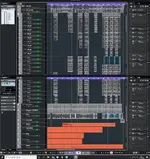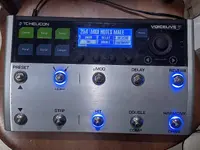Keep in mind, I'm recording on tape
Are you recording on reel to reel or cassette and how many tracks is your machine ? This can have an interesting effect on your harmonies and the sonic content, especially if you're having to bounce tracks together. Back in "the old days" quite a lot of the sounds that some of us have grown to love came about specifically due to the limitations inherent in 4 and 8 track tape recording and things like tape noise, generation loss due to bouncing and slight distortion at points. In these days of 160 separate tracks per song and clean sound, trying to recreate the sounds of yesterday sometimes sound artificial because one isn't having to work against the technology like they were in recording's infancy.
I want a specific ''sound'' but was never able to achieve it. I want to know how I would go about recording some vocal harmonies
Personally, I'm quite a lover of the "SF Sorrow" and "Parachute" albums and some of the singles and B sides they recorded in the same sessions, such as "Defecting grey," "Walking through my dreams," "Cold stone," "Summer time" and the one you mentioned "October 26." I think the albums are truly underrated but I can see why. "SF Sorrow" is damned hard work ! At least it is initially. It took me quite a few listens before it hit. Like with Nazz, at first I thought they were verging on tripe really.......Then they hit !
Those two Pretty Things albums are the kind that are hard to get until one gets them and then they're likely to make a convert of one forever.
In terms of vocal harmonies, I think they were way ahead of most of their contemporaries of the period; there have been so many groups and artists whose vocal harmonies at particular times I dig, ranging from Martha & the Vandellas to the Byrds to the Stones {on songs like "Dandelion" and "We love you"} and the Who to Bob Marley & the Wailers and the Wailing Souls to the Beatles to the Jackson 5 to various interpretations of Handel's "Messiah" and tons more besides......the Pretties sure take their place alongside them all and I tend to use them as inspiration and ideas of what can be done rather than try to recreate their sound. What I do find happens though, is that whenever I admire an artist's vocal harmony, I'll have it in mind when doing my own and what usually comes out is so idiosyncratic that you'd never guess who the artist I had in mind was.
What are they using on the voices?
"SF Sorrow" was recorded on 4 track and "Parachute" 8 track which meant a lot of bouncing, especially in trying to have the kind of thick sounding harmonies they ended up with. On the title track, Jon Povey layered himself 8 times in order to get that sound. A bit like the way the mellotron, because it was a tape based instrument, gave the instruments recorded within it's banks a certain sound because of its limitations and helped develop the sound of both psychedelia and one strand of nascent progressive rock, the vocal harmonies on those two Pretties albums make the most of the least but do so wonderfully. Lots of overdubbing and bouncing with natural chorusing and phasing taking place at unexpected times and some tape echo {which I presume is what they called reverb in those days though that's a guess on my part}. But I'd say the result was worth it. One thing I've long been a fan of since I started recording is varispeed. It seems to be one of the aspects of recording that has all but died whereas for me, it's a staple, both in terms of being able to play fast or complicated parts {especially on instruments I'm not au fait with} and with backing and harmony vocals ~ recording at different speeds changes the pitch of the voice and while it can be pretty lame for a solo vocal to go more than a semitone up or down, this is almost mandatory for massed backing vocals. If you haven't already, try it. Backing/harmony vocals are a normal part of my songs and varispeeding is key to that. It's also interesting being able to sing the same sequences in different keys, especially 6 or more semitones apart ! My current DAW has varispeeding and I can get 8 semitones apart which is more than enough. In my cassette portastudio days 6 was the maximum and that was plenty.
Much depends on whether all the voices will be that of just one person or whether you have the services of more than one singer. The Pretties had Phil May, Wally Waller, Jon Povey as well as their producer, Norman Smith and that blend of voices, as well as the way they were recorded plus the limitations, contributed hugely to their sound. I've been fortunate to have had a variety of vocalists that could sing well to well~ish and the various combos have made a unique and telling contribution to the sound of backing vocals on my stuff down the years.
One of the good things about varispeeding and massed vocals is that it doesn't even matter if one or two of the singers isn't a particularly good singer as long as at least one of you can keep in tune because the way you all place around the mic makes a difference too. For example, say you are going to record 5 tracks of backing vocals and there are 2 or 3 of you. Just make sure that for at least 3 of the tracks, the stronger vocalist is the one clo
sest to the mic. Closest doesn't necessarily mean right on top of it. If you record each track at a different speed, place yourselves in different places each time ~ around the mic, swap positions, sometimes have some of you sit on the floor while some stand, all go behind the mic, sometimes just some of you behind the mic, if there's room, all lie down on the floor, sometimes one lies, one sits, one stands etc. These are just suggestions but use your inventiveness. Sometimes sing high, sometimes low {yes, even with varispeeding}, sometimes sing in silly accents or accents that are not yours, cup your hands around your mouths, both together and separately, sometimes wobble your Adam's apple as you sing or sing with natural vibrato if you can, sing into or over the top of a bottle, sometimes all go out of the room or in a corner etc, etc. Sometimes do it all together, sometimes only some of you do it while others do it normally.
The point is to try and get as many different ways of getting a slightly different sound as possible. Some may sound awful on their own or unsatisfactory on their own or, when recorded at a different speed, just plain weird on their own. But you may find yourself very pleasantly surprised when you put them all together and start blending.




 I'm a minimalist ( lazy ass )
I'm a minimalist ( lazy ass )